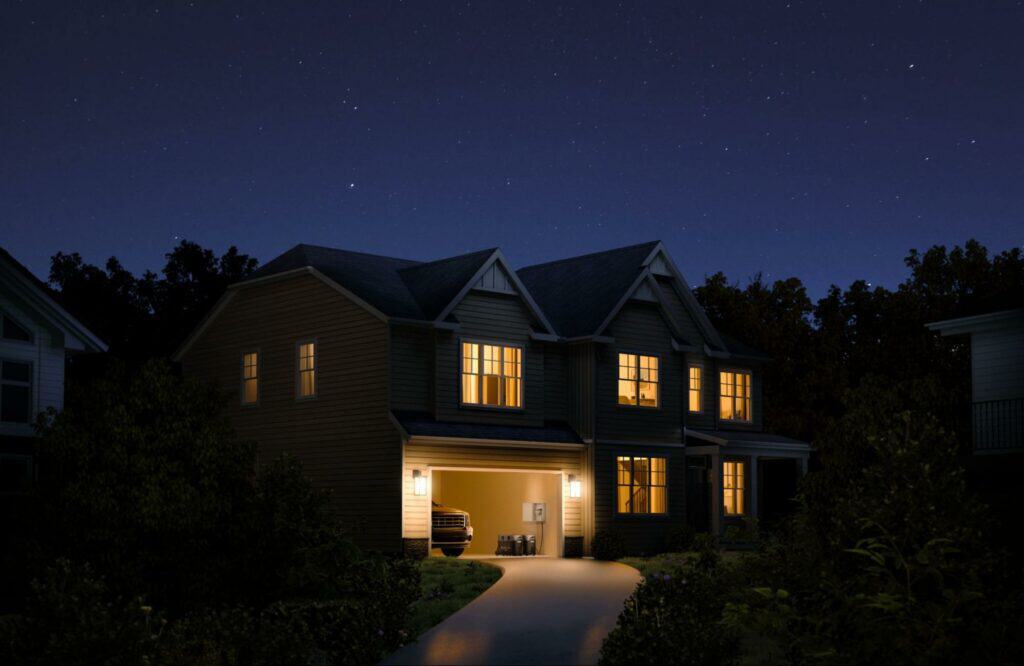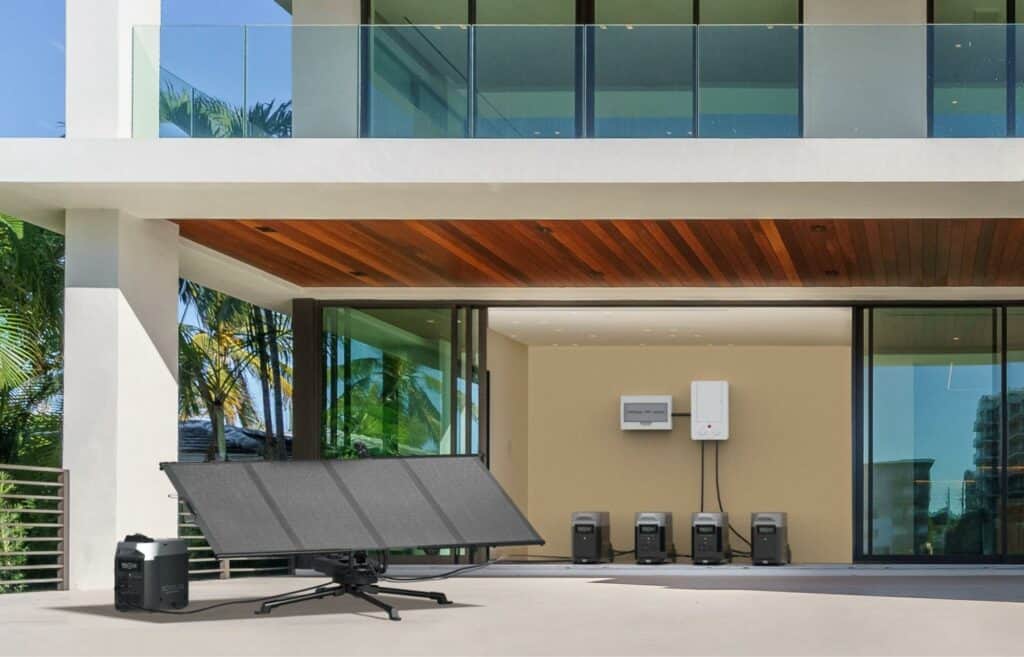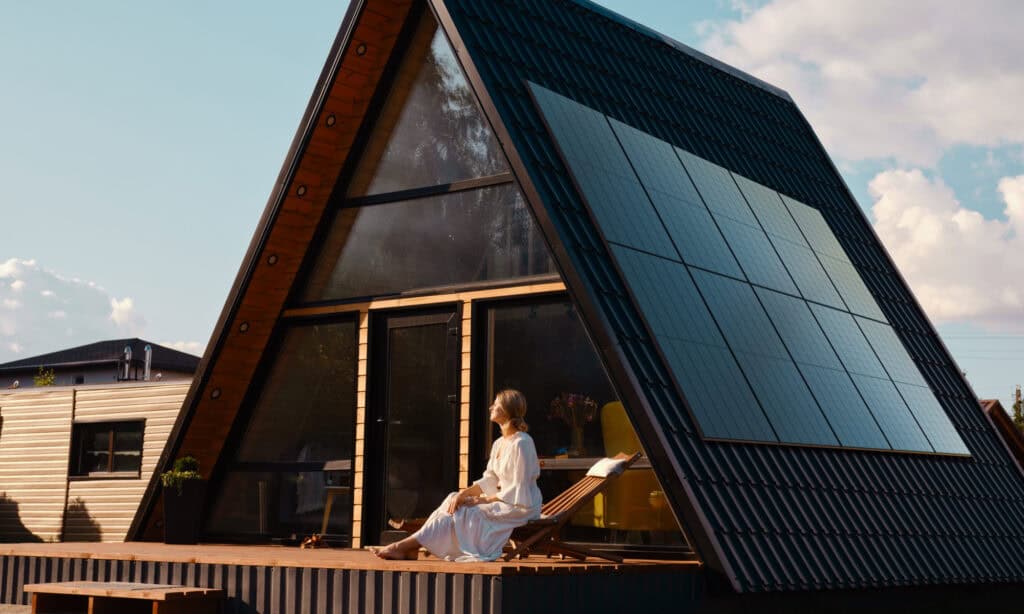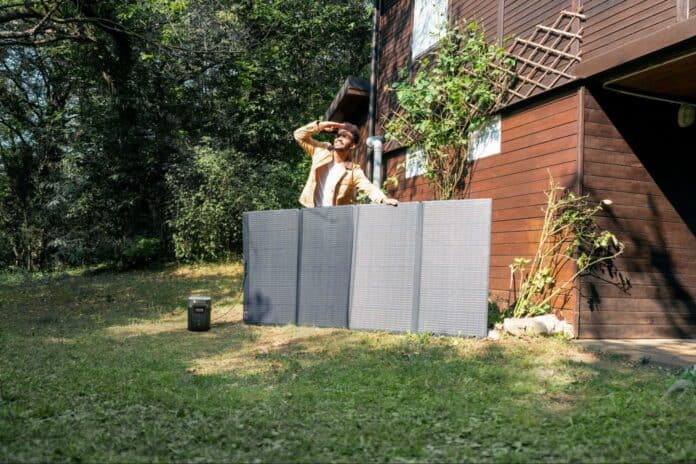Table of Contents
Many people have misconceptions about how solar panels work.
For example, solar energy systems that generate electricity rely on sunlight — not heat.
In fact, solar panels are actually less efficient in extremely high temperatures than they are in more moderate climates.
But if photovoltaic (PV) solar power systems that produce electricity need light, how do they work at night?
Read on to find out.
What Are Solar Panels and How Do They Work?
Solar panels are the most common type of PV modules.
They capture solar energy from sunlight and generate electricity using the photovoltaic effect.
The PV effect uses solar cell semiconductors and other components to harvest photons from visible light waves, not heat, ultraviolet (UV) or infrared (IR) light.
(Source: EIA)
Pure monocrystalline and polycrystalline silicon (cSi) solar wafers are the most commonly used semiconductive materials in PV cells.
According to the International Energy Agency, crystalline silicon (cSi) “remains the dominant technology for PV modules, with a market share of more than 97%.”
Other types of PV cells currently in use include:
- Passive Emitter and Rear Contact (PERC)
- Thin Film
- Perovskite
Learn more about the different types of solar panels.
PV modules are an essential component of any solar energy system that generates electricity, but they don’t work alone.
A balance of system (BOS) is required to transform the direct current (DC) electricity produced by solar panels in alternating current (AC) for storage, transmission to the power grid, or immediate use.
Depending on whether you opt for a grid-tied, off-grid, or hybrid solar panel system, you’ll need some (or all) of the following components.
- Solar inverter
- Solar battery*
- Charge controller*
- Battery management system*
- Cables and wiring
- Bidirectional or smart electricity meter**
- Transfer switch (for integration with home wiring)
* required for off-grid and hybrid systems
** required for on-grid and hybrid systems that send power to the grid
As long as they’re compatible, each of the above components—and the solar panels—can be purchased separately from different manufacturers.
However, many prefer a convenient all-in-one solar generator system, like EcoFlow DELTA Pro.
Can Solar Panels Generate Electricity at Night?
No. Photovoltaic modules — including solar panels — do not generate electricity after the sun goes down.
Like all clean, renewable energy sources, solar energy is intermittent.
Wind turbines don’t produce electricity on still days, and solar panels don’t work at night.
The photovoltaic effect relies on visible light from the sun to generate electricity — not heat.
The level of sunlight (solar irradiance) you receive at your location determines the amount of electricity any given PV module will produce.
Solar panels produce more electricity during peak sunlight hours than in the early morning or sunset.
A common mistake many people make when they first shop for a solar panel system is assuming the PV module will generate its full rated power in watts every daylight hour.
In reality, there are many reasons why solar panels don’t always generate their rated power for at least part of the day — and all of the night.
Standard Test Conditions for Solar Panels
| Condition Type | Standard Test Condition | Real-World Conditions |
| Solar Incident Angle | Always zero, irradiation beam always normal to the PV panel* | Variable, and depends on time, date, and site latitude. In the case of rooftop systems, roof orientation, and inclination govern system capacity. |
| Solar Irradiation | Always equal to 1000 Watts/m²* | Variable and depends on the time, date, and site latitude. Limited sunshine hours bound system capacity. |
| Ambient Temperature | Always 25°C* | Variable and depends on the time, date, weather condition, and site latitude. Higher ambient temperature degrades PV panel efficiency and reduces system output. |
| Air Mass Coefficient (AM) | Always equal to 1.5* | Variable and depends on the time, date, and site latitude. Higher AM with higher latitudes. |
| System Losses (e.g., Wiring, Inverter) | Always Zero* | Variable and depends on the design and location of PV panels, inverter, and grid meter. |
*Cannot be achieved in real-world operation (Source: ResearchGate)
Solar panel specifications — such as rated power and efficiency — are determined in a laboratory under ideal Standard Test Conditions.
Such environmental conditions rarely arise in the real world, at least not consistently.
Fortunately, solar panels perform adequately in all weathers during the day…
Just not at night.

How Do I Get Power at Night if I Have Solar Panels?
Intermittency is one of the primary challenges facing renewable energy systems.
Fortunately, there are several solutions for residential solar and portable off-grid power.
Read on to learn more.
Grid-Tied Solar
There are essentially three ways of dealing with the fact that solar panels don’t work at night.
The first is to opt for a grid-tied solar panel system.
On-grid solar systems connect bidirectionally to your local electricity provider or power company.
When your household electricity consumption exceeds the amount of power your solar panels generate, a bidirectional meter auto-switches to the utility grid.
In locations that offer net metering, you can also sell electricity to your power company when your energy production exceeds your consumption.
Net metering has its advantages. But it’s rarely (if ever) a money-making proposition, largely because you’ll have to use utility power every night.
However, if the solar panel array generates sufficient energy, it can reduce your electricity bills significantly.
Net metering arrangements vary depending on your energy provider and may not be available at your location.
In most circumstances, any money you earn by selling solar power is applied as a credit to your energy bill.
Depending on your location, on-grid solar can be a viable option. It requires fewer balance of system components than off-grid or hybrid solar systems, so it typically costs less upfront.
However, on-grid systems have one major drawback.
Grid-tied solar panel systems DO NOT work during a blackout.
On-grid systems without battery storage automatically shut down during a power outage to avoid injuring utility workers and prevent further damage to the grid.
You’ll be without power until the outage is over.
Off-grid and hybrid (solar + storage) systems can keep your house up and running indefinitely during a blackout.
(Source: Australia Research Council)
For many people, energy security is the #1 reason they want solar panels and home backup battery storage.
The severity of extreme weather and climate events in Australia is growing more extreme by the year.
Globally, 2023 was the hottest year on record, and 2024 is forecast to be even hotter.
Heatwaves frequently cause power outages when demand exceeds supply from ageing grid infrastructure.
Natural disasters bring down power lines and transformers.
In a recent report, the Australian Energy Market Operator (AEMO) said:
“The urgency for the timely delivery of transmission, generation and storage, and use of consumer electricity resources to support the grid remains to meet consumers’ energy needs.”
If want to protect your family from the consequences of climate change as well as reduce your carbon footprint, consider an off-grid or hybrid solar power system instead.
Off-Grid PV
Off-grid solar panel systems provide electricity with zero reliance on the utility grid.
Systems like EcoFlow’s Power Kits are ideal for remote locations, tiny homes, and full-timing in a motorhome or campervan.
The EcoFlow RIVER 2 series of portable power stations provides electricity for outdoor adventures in a lightweight unit and offers multiple recharging options — including portable solar panels.

Hybrid (Solar + Storage)
If you’re looking for residential solar power systems or backup, a hybrid system from EcoFlow’s DELTA series is more likely to fit the bill.
Hybrid systems combine PV panels + solar battery storage with the ability to recharge using grid power in addition to other charging methods.
For example, EcoFlow DELTA Pro can recharge using the following:
- Solar
- AC (Household Electricity)/
- Car Charger
- EcoFlow Smart Home Panel
- Electric Vehicle Charge Station
- EcoFlow Smart Inverter Generator
As part of EcoFlow’s Smart Home Ecosystem, DELTA Pro is also highly expandable and can easily run the high-wattage appliances and HVAC systems found in most homes.
DELTA Pro integrates with your home circuit board using an EcoFlow Smart Home Panel or transfer switch, and it can be recharged from the utility grid.
However, it’s not bidirectional and ineligible for net metering.
Fortunately, EcoFlow DELTA Pro can often save more money on electric bills than a grid-tied system.
Thanks to the EcoFlow app, you can monitor and control DELTA Pro from anywhere with an internet connection.
You can also schedule it to auto-switch to electricity stored in the LFP home backup battery during on-peak billing hours and back to the grid to recharge off-peak.
By avoiding consumption during peak demand, you can shave hundreds of dollars off of your power bill.
And that’s just one of the ways DELTA Pro can help you save on electricity bills every day.
Even more importantly, you’ll gain peace of mind by knowing you’ve got home backup power available for the next time there’s a blackout.
Do Solar Panels Work on Cloudy Days?
Yes, solar panels generate electricity on overcast days, but the output wattage of the array will decrease.
A surprising amount of visible sunlight makes it through cloud cover, even on the darkest days.
If you live in a frequently overcast area, consider investing in bifacial solar panels.
Unlike conventional units, bifacial PV panels have photovoltaic cells on both the front and the rear of the panel, allowing you to maximise electricity generation from ambient sunlight.
For example, EcoFlow’s NextGen 220W Bifacial Portable Solar Panel allows you to produce significantly more power from the visible light available, even during a storm when you can’t really see it.
It’s especially effective when placed on a reflective surface.
Frequently Asked Questions
The moon reflects visible light produced by the sun, so technically, solar panels can use moonlight to generate electricity. However, even the brightest, fullest moon won’t produce enough light to generate more than 0.2 – 0.3% of a solar panel’s rated power. For example, the maximum electricity a 400W solar panel can generate in moonlight is about 3.2 watts.

Final Thoughts
The supply of renewable energy sources like solar, wind, and hydropower is virtually limitless, but each presents unique challenges when it comes to making sustainable electricity generation work.
Fortunately for consumers looking to switch to solar power, governments, companies, and institutions around the world spend many trillions of dollars on clean energy innovation.
Thanks to increasing demand and rapidly evolving technology, most obstacles to consumer adoption of solar power have been overcome, and the cost of switching to solar has never been lower.
If you’re interested in solar panels and an off-grid or hybrid PV system that provides home energy security — and electricity at night — look no further.
EcoFlow offers a wide range of PV panels, portable power stations, and solar generators for home and recreational use.
Check out our selection today!


